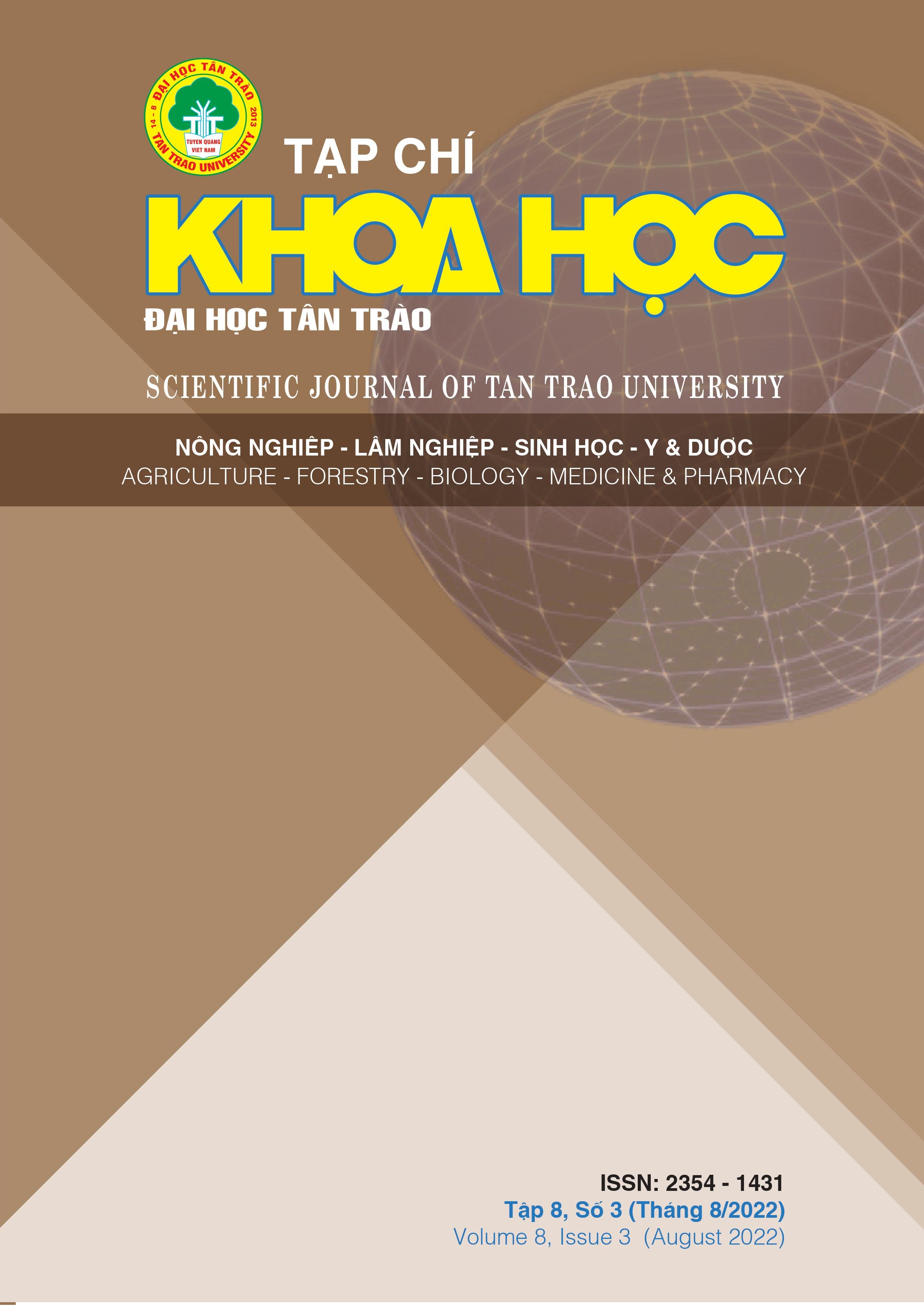ĐÁNH GIÁ NHẬN THỨC CỦA NGƯỜI DÂN XÃ PHÚ THỊNH, HUYỆN ĐẠI TỪ, TỈNH THÁI NGUYÊN VỀ PHÂN LOẠI CHẤT THẢI RẮN SINH HOẠT TẠI NGUỒN
DOI:
https://doi.org/10.51453/2354-1431/2022/799Từ khóa:
Äánh giá nháºn thức, Chất thải rắn sinh hoạt, Phân loại chất thải rắn sinh hoạt, Ô nhiá»…m môi trÆ°á»ng, xã Phú ThịnhTóm tắt
Chất thải rắn sinh hoạt (CTRSH) là một trong những tác nhân gây ra ô nhiễm môi trường, ảnh hưởng đến đời sống, sức khỏe cộng đồng. Nghiên cứu này được thực hiện dựa trên phương pháp phân tích tổng hợp tài liệu, phương pháp thực nghiệm, phương pháp điều tra và phương pháp thống kê mô tả. Kết quả nghiên cứu cho thấy: Chỉ số phát sinh chất thải rắn sinh hoạt tại xã Phú Thịnh là 0,66kg/người/ngày, cao gấp 2,27 lần so với bình quân tại khu vực trung du miền núi phía Bắc. Nhận thức của người dân xã Phú Thịnh về phân loại CTRSH tại nguồn được đánh giá thông qua hiểu biết, thái độ và hành vi của người dân, đạt 6,58 điểm quy đổi. Người dân có nhận thức khá tốt về phân loại CTRSH. Nhóm tác giả đề đề xuất 2 giải pháp nâng cao nhận thức của người dân: Chính quyền địa phương tăng cường tuyên truyền về phân loại CTRSH đến các hộ gia đình và đẩy mạnh vai trò của Đoàn thanh niên, hội Phụ nữ... trong công tác tuyên truyền, quản lý CTRSH tại nguồn.
Tải xuống
Tài liệu tham khảo
[1]. Bộ Tài nguyên và Môi trường (2019), Báo cáo Hiện trạng môi trường Quốc gia 2019, chuyên đề quản lý chất thải rắn, NXB Dân trí, trang 18, 2020.
[2]. Nguyễn Thị Hồng Viên, Chu Thị Hồng Huyền (2018), “Xây dựng mô hình quản lý rác thải tại xã Quảng Bạch, huyện Chợ Đồn, tỉnh Bắc Kạn”, Tạp chí Khoa học và Công nghệ ĐHTN, tập 189, số 13, trang 135 - 142, 2018.
[3]. Nguyễn Thị Hồng Viên, Chu Thị Hồng Huyền, Nguyễn Thu Huyền, Nguyễn Thị Đông (2022), “Đánh giá nhận thức của người dân phường Hoàng Văn Thụ, thành phố Thái Nguyên về phân loại rác thải sinh hoạt tại nguồn”, Tạp chí Khoa học và Công nghệ ĐHTN, tập 227, số 09, trang 408 - 414, 2022.
[4]. Lương Thị Mai Ly, Phạm Minh Chinh (2013), “Đánh giá hiện trạng và dự báo tình hình phát sinh chất thải rắn sinh hoạt của tỉnh Quảng Bình đến năm 2020,” Tạp chí Nghiên cứu Địa lý Nhân văn, tập 1, số 1, trang 25 - 30, 2013.
[5]. Cổng thông tin điện tử xã Phú Thịnh, huyện Đại Từ (2020), Giới thiệu chung về xã Phú Thịnh, http://phuthinh.daitu.thainguyen.gov.vn/gioi-thieu-chung/
[6]. Nguyễn Thanh Giao, Nguyễn Thị Ngọc Trăm (2000), “Nghiên cứu sơ bộ thành phần và hiện trạng quản lý chất thải nhựa tại xã Long Trị A, huyện Châu Thành, tỉnh Hậu Giang”, Tạp chí Tài nguyên và Môi trường, Trường Đại học Tài nguyên và Môi trường Hà Nội, tập 31, trang 76- 85, năm 2020.
[7]. Nguyễn Thị Nhâm Tuất (2000), “Đánh giá hiện trạng và đề xuất giải pháp quản lý chất thải rắn sinh hoạt trên địa bàn tỉnh Bắc Ninh”, Tạp chí Khoa học và Công nghệ ĐHTN, tập 225, số 06, trang 355 - 361, năm 2020.
[8]. Ngô Văn Giới, Cao Minh Chính, Nguyễn Thị Nhâm Tuất (2000), “Thực trạng và giải pháp nâng cao hiệu quả quản lý chất thải rắn sinh hoạt trên địa bàn huyện Điện Biên, tỉnh Điện Biên”, Tạp chí Khoa học và Công nghệ ĐHTN, tập 225, số 06, trang 396 - 404, năm 2020.
Tải xuống
Đã Xuất bản
Cách trích dẫn
Số
Chuyên mục
Giấy phép

Tác phẩm này được cấp phép theo Giấy phép Quốc tế Creative Commons Attribution-ShareAlike 4.0 .
Bài báo được xuất bản ở Tạp chí Khoa học Đại học Tân Trào được cấp phép theo giấy phép Ghi công - Chia sẻ tương tự 4.0 Quốc tế (CC BY-SA). Theo đó, các tác giả khác có thể sao chép, chuyển đổi hay phân phối lại các bài báo này với mục đích hợp pháp trên mọi phương tiện, với điều kiện họ trích dẫn tác giả, Tạp chí Khoa học Đại học Tân Trào và đường link đến bản quyền; nêu rõ các thay đổi đã thực hiện và các nghiên cứu đăng lại được tiến hành theo cùng một bản quyền.
Bản quyền bài báo thuộc về các tác giả, không hạn chế số lượng. Tạp chí Khoa học Tân Trào được cấp giấy phép không độc quyền để xuất bản bài báo với tư cách nhà xuất bản nguồn, kèm theo quyền thương mại để in các bài báo cung cấp cho các thư viện và cá nhân.
Mặc dù các điều khoản của giấy phép CC BY-SA không dành cho các tác giả (với tư cách là người giữ bản quyền của bài báo, họ không bị hạn chế về quyền hạn), khi gửi bài tới Tạp chí Khoa học Đại học Tân Trào, tác giả cần đáp ứng quyền của độc giả, và cần cấp quyền cho bên thứ 3 sử dụng bài báo của họ trong phạm vi của giấy phép.






